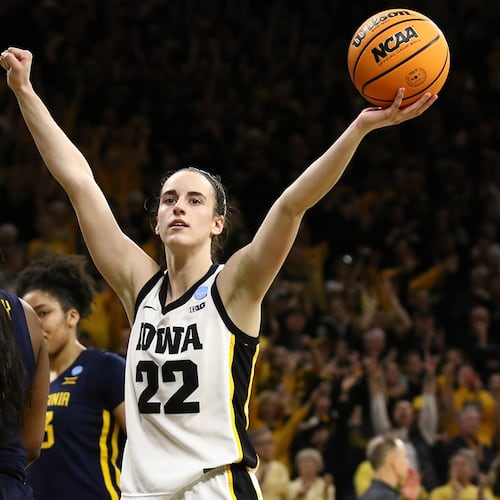The belief is that Todd Stansbury, Georgia Tech’s athletic director, doesn’t want to fire his football coach. Events, however, aren’t cooperating. The Yellow Jackets are 3-4. The only Power 5 team they’ve beaten is Louisville, which might be the worst Power 5 team.
It's still possible, at least mathematically, that Tech could win its division, though it has three ACC losses. (No other Coastal team has that many.) If we go by ESPN's Football Power Index, the Jackets are projected to finish 5-7. They were 5-6 last year, 3-9 in 2015. They were 9-4 in 2016 with wins over Virginia Tech and Georgia, but still: A coach at a Power 5 school cannot have three losing seasons in four and expect any reservoir of job security.
The belief is that 5-7 would leave Stansbury hanging. A 4-8 season might be enough to force his hand; a 6-6 year, while nothing to celebrate unless the sixth victory is over Georgia, would surely mean that Paul Johnson returns for 2019. (Assuming he wants to be back.) But there could be a bigger issue than W’s, or the lack thereof.
Tech lost Saturday to Duke for the fourth time in five seasons. Note that David Cutcliffe, who’d been fired at Ole Miss, was hired by the Blue Devils just after Johnson was tapped to replace Chan Gailey at the Flats. (Note also that Cutcliffe had keen interest in the Tech job but was never interviewed; Dan Radakovich, then Tech’s AD, had settled on Johnson after thinking hard about Rick Neuheisel.)
From 2008 through 2013, Cutcliffe’s Devils never beat Johnson’s Jackets. The scores of those games: 27-0, 49-10, 30-20, 38-31, 42-24 and 38-14. Duke has won every game since but one, and the exception, which came in 2016, required two remarkable Justin Thomas runs in the final nine minutes of a breathless 38-35 victory. Otherwise, the Devils have won by six, 14, 23 and 14 points. Coaches speak of flipping the field. Here’s a series that has flipped.
It would be one thing if, say, North Carolina was the team now beating Tech on a regular basis. Carolina is the flagship school of a populous state. The Jackets represent the Georgia Institute of Technology. Tech could rightly claim that, to borrow Urban Meyer’s imagery, the checkers in a GT-UNC comparison weren’t equal.
Duke is different. Duke is a private school with roughly one-third of Tech’s enrollment. Duke is not North Carolina in terms of in-state popularity; it’s not even N.C. State. Duke football isn’t the biggest sport on its Gothically-themed campus.
Last month, Stansbury conceded in an email to supporters that Tech has "slowly fallen behind our competition in terms of the resources needed to assist our student-athletes and coaches when they line up week-in and week-out against programs that have those resources." That's true when the opponents are Clemson and Georgia. But can we say that Duke football has, resource-wise, lapped Georgia Tech? (Duke's Wallace Wade Stadium has a capacity of 40,004.)
Yes, Duke has put more money into football. Every ACC school has. Tech is spending, too. It had an indoor practice facility before its Athens neighbor. It has hired support personnel in the effort to buttress recruiting. It redid its locker room. The Jackets will never spend what Georgia or Clemson do, but let’s not paint Duke as some football factory – not with Mike Krzyzewski perched in his ornate office.
That Tech is 1-4 since 2013 against the Coastal rival to which it bears the greatest resemblance – it lost to Duke even in its Orange Bowl year – is the greatest indictment of Johnson. He once owned the Devils; they now own him. If he argues that he needs more money to keep up with the Cutcliffes, Stansbury might ask, “Where do you suggest we get it?”
The gathering for Tech’s latest loss to Duke was 41,709 – Tech’s smallest homecoming gate since 1994, the year Bill Lewis quit with three games remaining. Some of that was because the Jackets are 20-23 since the Orange Bowl rout of Mississippi State. Some of it is because Johnson’s offense isn’t a magnet for eyeballs. Therein lies the tangle.
If the only way up for Tech is to spend more, is a coach whose team plays a retro brand of football apt to persuade donors to dig deeper? Even if Stansbury has every intention of sticking with Johnson – the AD expressed “total support” in September – wouldn’t keeping a coach after a third losing season in four make a hard sell that much harder?
Owing to the two-year extension Stansbury granted Johnson last spring, Johnson’s contract runs through 2022. At the rate he’s going, it’s hard to imagine him getting to 2020. Results will have to change posthaste, and there’s no guarantee that spending bigger will be enough. All the money in the world won’t make Tech, as coached by a man who scoffs at recruiting rankings, into a stockpile of 5-stars.
There was a time when Johnson could take his 3-stars and, to use Stansbury’s phrase, “fight above their weight class.” That hasn’t happened as much lately. He’s 1-3 against Pitt’s Pat Narduzzi, and the two-touchdown homecoming loss to Duke was the worst possible result at the worst possible time. The Devils should never be above Tech’s weight class.
These next five games should serve as Johnson's closing argument. If he wins three, he figures to keep his job. If he doesn't, it could force Stansbury to do something he doesn't want to do. I'm on record as believing the next Tech coach mightn't do as well as Johnson, but the incumbent really does need to give his boss some reason not to seek a next coach.
About the Author
The Latest
Featured


